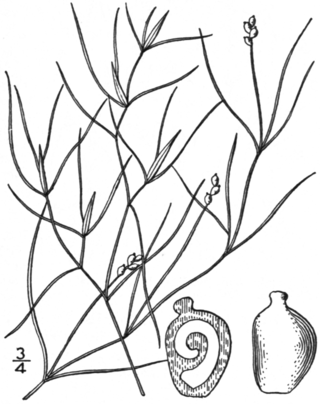
Viburnum nudum is a deciduous shrub in the genus Viburnum within the muskroot family, Adoxaceae.

Viola nephrophylla syn. Viola nephrophylla Greene f. albinea (Farw.), Viola pratincola Greene, Viola retusa Greene ) is an annual or perennial forb in the Violet family (Violaceae) native to North America.
Puccinellia pumila is a species of grass known by the common names dwarf akaligrass and smooth alkali grass. It is native to North America where it grows along the coastline in the northern latitudes, from Alaska across Arctic northern Canada to Greenland. It occurs on the coast of the Pacific Northwest in the United States and it is known from the Kamchatka Peninsula. The grass is only found on the coast, in wetland habitat, beaches, and areas inundated by the highest tides, in saline sand and mud. This perennial grass grows decumbent or erect to a maximum height near 40 centimeters, often remaining much smaller, especially in harsh habitat. It may root at stem nodes which become buried in wet substrate. The inflorescence is a dense or open array of branches bearing spikelets.

Doellingeria infirma, the cornel-leaf whitetop or cornel-leaved aster, is a perennial forb native to the eastern United States, that produces white composite flowers in late summer.

Sagittaria teres, the quill-leaved arrowhead or slender arrowhead, is an aquatic plant species in the genus Sagittaria native to the northeastern United States: Rhode Island, Massachusetts, New Hampshire, New York and New Jersey.

Aristida tuberculosa, common names seaside threeawn, seabeach needlegrass, beach three-awned grass and beach needlegrass, is annual plant native to the United States.

Aristida longespica is a species of grass known by the common name slimspike threeawn. Aristida longespica var. geniculata is listed as a species of special concern in the State of Connecticut.

Botrychium simplex, the little grapefern, is a species of fern in the family Ophioglossaceae that is native to North America and Greenland. It is a perennial.

Draba reptans, common names Carolina draba, Carolina whitlow-grass, Creeping whitlow-grass, and Whitlow-grass, is an annual plant in the family Brassicaceae that is native to North America.

Spiranthes tuberosa, commonly called little lady's tresses, little pearl-twist and slender ladies'-tresses is an orchid species. It is a perennial plant native to North America.

Carex schweinitzii, common name Schweinitz's sedge, is a Carex species native to North America. It is a perennial.

Dichanthelium leibergii, known as variously as Leiberg's panicum, Leiberg's panicgrass, Leiberg's rosette grass, and prairie panic grass is a species of grass native to North America. It was named for its discoverer, John Bernhard Leiberg (1853-1913), a Swedish-born American botanist active in the western United States.

Dichanthelium scabriusculum common names tall swamp rosette-panicgrass, tall swamp panicgrass, rough panic-grass and panic grass, is a species of plant found in North America. It is listed as endangered in Connecticut, Maryland, and New York (state). It is listed as threatened in Massachusetts.

Dichanthelium ovale, commonly known as eggleaf rosette grass, is a plant found in North America. Dichanthelium ovale subsp. pseudopubescens, common name Stiff-leaved rosette-panicgrass is listed as a special concern and believed extirpated in Connecticut.

Piptatherum pungens, also called Oryzopsis pungens, commonly called slender mountain-ricegrass, ricegrass, northern ricegrass, or slender mountain-rice, is a plant found in North America. It is listed as endangered in Connecticut, Iowa, New Jersey, and Pennsylvania. It is listed as extirpated in Indiana, as a special concern in Rhode Island, and as threatened in Vermont.

Potamogeton gemmiparus, is a species of plant found in North America. It is also known as Potamogeton pusillus var. gemmiparus, common names capillary pondweed, slender pondweed, and budding pondweed. It is listed as threatened in Connecticut and in New Hampshire, as rare in Indiana, and as a special concern in Rhode Island.

Cryptogramma stelleri, common names slender cliff-brake, fragile rock-brake, slender rock-brake, and Steller's rockbrake, is a plant found in North America. It is listed as endangered in Connecticut, Massachusetts, New Jersey, and Pennsylvania. It is listed as threatened in Maine and New Hampshire, as exploitably vulnerable in New York (state) and as sensitive in Washington (state).

Sporobolus clandestinus, common names rough dropseed and rough rushgrass, is a species of grass found in North America. It is listed as endangered in Connecticut., Maryland, New York (state), and Pennsylvania. It is listed as threatened in Kentucky.

Dichanthelium sphaerocarpon, also called Panicum polyanthes, common name round-seed panic grass, is a plant found in North America. It is listed as endangered in Michigan. Dichanthelium sphaerocarpon var. isophyllum is listed as a special concern and believed extirpated in Connecticut.


















